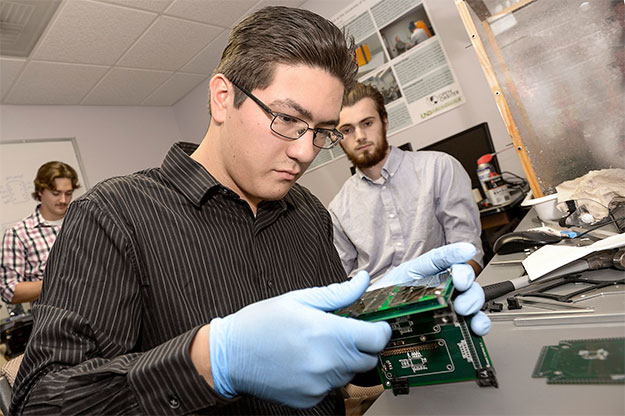First in flight
UND and NDSU students collaborate on what would be North Dakota’s pioneer free-flying satellite

The Space Race that took place between the United States and the Soviet Union at the height of the Cold War is well documented in history.
But there’s another sprint to the stars taking place right now on the Northern Plains involving UND and NDSU. This one, however, is a bit more collegial.
In fact, it’s downright collaborative.
Teams at both Universities are designing their own miniature versions of a satellite that one day — as soon as early next year — will carry a research payload in orbit. Though they’re working on separate satellites, they have a common goal: to build the best miniature orbiter possible. Ultimately, the top-performing components from each university’s version will be combined as a final product. That version will be launched into space and stored on the International Space Station (ISS) until it’s released into orbit, according to Jeremy Straub, coordinator of the satellite project.
The satellite, or “CubeSat,” as it’s called, because of its cubed shape and minute dimensions — less than 11 inches on all sides — would be the first North Dakota-built satellite to be launched into orbit. It’s only fitting, then, that it’s developed by students from two of the state’s biggest research universities.
Straub personifies the collaboration taking place at UND and NDSU. He has roots at UND, having recently received his Ph.D. in computer sciences there. He currently is a faculty member in NDSU’s Computer Science and Operations Research division. His work with CubeSats actually started as a Ph.D. student at UND.
Because of size constraints and other scientific challenges, the UND and NDSU students have been forced to be innovative and creative with their approaches. They’ve also tapped into cross-disciplinary sources of support at their respective campuses to tackle various questions.
“The project always has been very student-centered and student-led at both schools,” Straub said. “So what will happen is that if the students need a particular resource, they will simply go and seek out what they need. At various points at UND, there have been people from every college involved with the project.”

Straub estimates that between the two universities, upwards of 90 students have had some involvement with the project.
Karl Schmaltz, a UND electrical engineering student from Stillwater, Minn., ensures that all of CubeSat’s components are powered correctly and functioning and communicating with each other. He said it beats sitting in a classroom.
“This is complete hands-on work,” Schmaltz said. “We’re learning everything by ourselves, with the help of others when we need it, and we’re learning to meet strict deadlines and communicating with the other teams at NDSU, which is another big deal.”
For Skye Leake, a native North Dakotan from Emerado, the significance of students from UND and NDSU — two traditional rivals since the early days of statehood — working together is not lost on him.
“That doesn’t always work the best (in many other cases),” said Leake, with a smile. “That’s not to say that I don’t have some good friends from NDSU. But there definitely is some well-intentioned ribbing that goes on with this project. Through it all, though, everyone has been really cooperative.”
Leake, a UND mechanical engineering student, focuses on the satellite’s physical structures and its ability to safely carry its scientific payload into space and eventually into orbit.
“The satellite is not necessarily the most technologically advanced thing to go up in space,” he said, “but it’s certainly a stepping stone for this institution. Definitely, there are longer term plans for bigger and better; the long term is where it really starts getting interesting.”
Leake is referring to the potential for the research payload aboard the North Dakota CubeSat: a specially modified and tiny 3D printer (roughly 5 x 5 x 8 cm). There already is a 3D printer aboard the ISS, but it’s in a relatively warm and comfy zero-gravity setting. If all goes right, the orbiting CubeSat will provide the ultimate laboratory to conduct basic scientific studies on how a 3D printer copes with the vacuum, low pressure and harsh cold of a micro-gravity environment.
“Getting all three at the same time on Earth would be very difficult,” Straub said. “This gives us the opportunity to test all of the different factors at one time.”
The benefit of 3D printers is that they let space travelers transport smaller, lighter and less expensive raw materials that can be used later to build critical tools and other assets in remote environments where resources are scarce.
Straub said that a lot of coordination needs to take place before NASA finally makes the call on when North Dakota’s CubeSat might launch. He’s expecting that call to come sometime in early 2017. When it does go up, it’s slated to launch from Wallops Island off the Virginia coast.
“It’s only fitting, then, that it’s developed by students from two of the state’s biggest research universities.”


